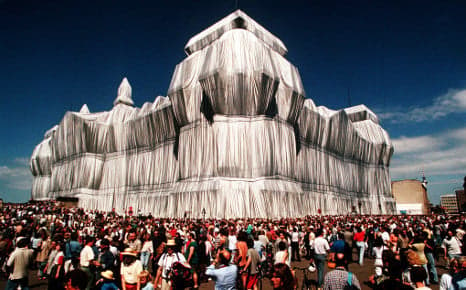How the Reichstag was wrapped in plastic

Twenty years ago, between the 17th and 24th June 1995 the renowned artist couple Christo and Jeanne-Claude unveiled their latest and most extravagant artwork - they had wrapped the Reichstag in plastic, at a cost of $4 million.
The two influential artists were well-known for their large-scale conceptual pieces of art. They used their own profits from previous works of art and defended their art as being purely aesthetic with no deeper purpose.
But Christo has also claimed his motivation was to illustrate the end and beginning of an era with the wrapping and unwrapping of one of the most famous buildings in Germany. This project is considered to be one of the most important work's of his lifetime.
Over 100,000 square metres of polypropylene fabric with an aluminum surface was used for the wrapping, along with over 15km of blue rope.
Ninety professional climbers and 120 installation workers helped erect the wrapping in two days before everything, including the 220 tons of steel structure, was recycled after the art project.
The project is thought to have cost $10 million, $4 million more than originally anticipated.
The couple had tried to get the go-ahead for the project for nearly 20 years, but it was only in February 1994 that it was finally voted through the Bundestag (German parliament) by 292 votes to 223. The ex-Chancellor Helmut Kohl was one of the politicians who strongly opposed the idea.
The wrapping of the Reichstag was delayed following winds so strong the building could not be worked on for a day.
It is estimated that over 5 million people came to see the project before it was taken down in July.
Christo’s other notorious works of art include wrapping the Florida islands in pink fabric.
He believed the Reichstag to be important due to its rich history.
Building work began on the Reichstag in 1884 under orders from Chancellor Otto von Bismarck.
But it burned down in 1933 in mysterious circumstances which the Nazi Party used to strengthen its hold on power in the turbulent inter-war period.
In 1945 it was nearly destroyed during the last days of the Second World War.
The 131 year old Reichstag enjoyed another restoration when the materials came down, preceding the move of the Parliament from Bonn to Berlin. The famed British architect Sir Norman Foster won a competition to redesign it, giving it its distinctive glass dome.
The wrapping of the Reichstag was one exuberant moment for a building with a rich history.
Comments
See Also
The two influential artists were well-known for their large-scale conceptual pieces of art. They used their own profits from previous works of art and defended their art as being purely aesthetic with no deeper purpose.
But Christo has also claimed his motivation was to illustrate the end and beginning of an era with the wrapping and unwrapping of one of the most famous buildings in Germany. This project is considered to be one of the most important work's of his lifetime.
Over 100,000 square metres of polypropylene fabric with an aluminum surface was used for the wrapping, along with over 15km of blue rope.
Ninety professional climbers and 120 installation workers helped erect the wrapping in two days before everything, including the 220 tons of steel structure, was recycled after the art project.
The project is thought to have cost $10 million, $4 million more than originally anticipated.
The couple had tried to get the go-ahead for the project for nearly 20 years, but it was only in February 1994 that it was finally voted through the Bundestag (German parliament) by 292 votes to 223. The ex-Chancellor Helmut Kohl was one of the politicians who strongly opposed the idea.
The wrapping of the Reichstag was delayed following winds so strong the building could not be worked on for a day.
It is estimated that over 5 million people came to see the project before it was taken down in July.
Christo’s other notorious works of art include wrapping the Florida islands in pink fabric.
He believed the Reichstag to be important due to its rich history.
Building work began on the Reichstag in 1884 under orders from Chancellor Otto von Bismarck.
But it burned down in 1933 in mysterious circumstances which the Nazi Party used to strengthen its hold on power in the turbulent inter-war period.
In 1945 it was nearly destroyed during the last days of the Second World War.
The 131 year old Reichstag enjoyed another restoration when the materials came down, preceding the move of the Parliament from Bonn to Berlin. The famed British architect Sir Norman Foster won a competition to redesign it, giving it its distinctive glass dome.
The wrapping of the Reichstag was one exuberant moment for a building with a rich history.
Join the conversation in our comments section below. Share your own views and experience and if you have a question or suggestion for our journalists then email us at [email protected].
Please keep comments civil, constructive and on topic – and make sure to read our terms of use before getting involved.
Please log in here to leave a comment.